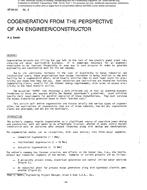
SF-86-03-3 — Cogeneration from the Perspective of an Engineer/Constructor
- Comments Off on SF-86-03-3 — Cogeneration from the Perspective of an Engineer/Constructor
- ASHRAE
Cogeneration projects are filling the gap left by the lack of new electric power plant construction and major modification business. It is sometimes necessary for an engineer/ constructor to be involved financially in some way in such projects in order to generate engineering and construction work for his own company.
Due to the continuing increases in the cost of electricity to large industrial and institutional users, these organizations have become interested in being involved as the host facility for a cogeneration plant, which usually entitles them to much lower costs for electricity and steam than they now pay. Some industries and institutions are themselves building cogenerating plants, usually for the thermal energy requirements, with sales of excess electricity to the local electric utility.
The so-called “PURPA” laws encourage a more efficient use of fuel by granting economic incentives to those who operate within the federal government’s guidelines. Local utilities specify their requirements for parallel operation of these installations. They must purchase the excess electricity generated based on their “avoided cost.”
This article will define cogeneration and discuss briefly the various types of cogeneration, two applications of cogeneration that are of broad interest, how and why cogeneration plants are developed, and who are the developers.
Units: I-P
Citation: Symposium, ASHRAE Transactions, 1986, vol. 92, pt. 1B, San Francisco
Product Details
- Published:
- 1986
- Number of Pages:
- 8
- File Size:
- 1 file , 940 KB
- Product Code(s):
- D-SF-86-03-3

